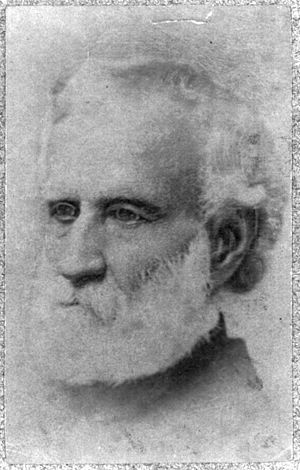Thomas T. Fauntleroy (soldier) facts for kids
Quick facts for kids
Thomas T. Fauntleroy
|
|
|---|---|
 |
|
| Member of the Virginia House of Delegates from the Fauquier County district |
|
| In office December 1, 1823 – November 28, 1824 Serving with John Marshall, Jr.
|
|
| Preceded by | Eppa Hunton |
| Succeeded by | John Robert Wallace |
| Personal details | |
| Born | October 6, 1796 Richmond County, Virginia, U.S. |
| Died | September 12, 1883 (aged 86) Leesburg, Virginia |
| Military service | |
| Allegiance | |
| Branch/service | United States Army Provisional Army of Virginia |
| Years of service | 1812–1814, 1836–1861 1861 |
| Rank | Brigadier General (Virginia) |
| Commands | 1st U.S. Dragoons Department of New Mexico |
| Battles/wars | War of 1812 Second Seminole War Mexican–American War Indian Wars American Civil War |
Thomas Turner Fauntleroy (born October 6, 1796 – died September 12, 1883) was an important person from Virginia. He was a lawyer and served in the state government. He was also an officer in the United States Army for many years. When the American Civil War began, he briefly served Virginia's military. However, he chose not to become a general in the Confederate Army.
Contents
Early Life and Career
Thomas Turner Fauntleroy was born in Clarke County, Virginia. His parents were Joseph and Elizabeth Fauntleroy. He had several younger brothers who grew up with him.
When he was only 17 years old, Thomas joined the U.S. Army. This was during the War of 1812. After the war, he studied law in Winchester, Virginia. He then became a lawyer in Warrenton, Virginia.
In 1862, he married Ann Magdelin Magill. They had four children who lived to be adults. These included Thomas Turner Fauntleroy, Jr., Mary Thurston Fauntleroy Barnes, Katherine Knox Fauntleroy Whittlesey, and Archibald Magill Fauntleroy. His first son, C.N. Fauntleroy, later joined the Confederate Navy.
In 1823, Thomas was elected to the Virginia House of Delegates. This meant he helped make laws for Virginia. He served for one term, representing Fauquier County, Virginia.
Serving in the U.S. Army
Thomas Fauntleroy became a major in the dragoons (a type of cavalry) in 1836. He fought in the Second Seminole War in Florida. He also helped keep Native American groups peaceful on the Texas border.
He was promoted to lieutenant colonel in 1846. He joined General Zachary Taylor's army during the Mexican–American War. Later, he led the cavalry for General Winfield Scott's army. This army captured Mexico City.
In 1849, he took command of the First Regiment of Dragoons. He led troops on duty in Texas. His next job was commanding a post at Mission San Diego de Alcalá in San Diego. He was promoted to colonel in 1850. After that, he commanded Fort Vancouver in Oregon Territory.
During the winter of 1854–1855, Colonel Fauntleroy led a campaign against the Utes in the Rocky Mountains. In 1858, he led another winter campaign against the Apache in New Mexico. He also went on several trips against the Apaches with a famous scout named Kit Carson. From 1859 to 1861, Colonel Fauntleroy was in charge of the U.S. Army's operations in New Mexico.
American Civil War and Later Life
While Colonel Fauntleroy was serving in the West, his son, Thomas Jr., became a lawyer. His son also followed in his footsteps by being elected to the Virginia House of Delegates.
When the American Civil War started in April 1861, Virginia decided to leave the United States. Colonel Fauntleroy resigned from the U.S. Army in May 1861. He returned to Virginia, his home state. The Governor of Virginia, John Letcher, made him a brigadier general in Virginia's army.
However, the Confederate States Army was formed soon after. Virginia's army then joined the Confederate Army. General Samuel Cooper offered Fauntleroy a position as a general in the Confederate Army. But Fauntleroy chose not to accept it. He asked to be relieved of his rank in August 1861. This means he never officially served as a Confederate general.
After the war, Thomas Fauntleroy retired. He lived near Winchester, Virginia, with his son Thomas Jr.'s family.
His oldest son, C. M. Fauntleroy, was a U.S. Navy officer who joined the Confederate Navy. He commanded a ship called the CSS Rappahannock. His second son, Thomas T. Fauntleroy, became a lawyer and politician in Virginia. After the war, he became a judge. Another son, Archibald Magill Fauntleroy, was a surgeon in the Confederate army and later a doctor. One of his daughters, Mary Thurston Fauntleroy, married Joseph Barnes, who was a Surgeon General for the U.S. Army.
Thomas Turner Fauntleroy died in Leesburg, Virginia, on September 12, 1883. He was buried at Mount Hebron Cemetery in Winchester.
Images for kids


